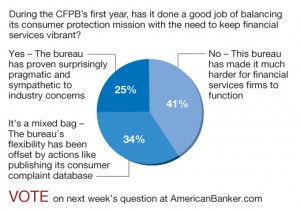Cordray Escapes Congressional Lion’s Den
By Kevin Wack
JUL 24, 2012 5:31pm ET
WASHINGTON – For all the hostility that congressional Republicans have directed at the Consumer Financial Protection Bureau, the agency’s director appears to be adept at escaping their wrath.
Richard Cordray faced off Tuesday against the congressional panel most suspicious of his agency, an oversight subcommittee chaired by GOP Rep. Patrick McHenry. While Cordray did not exactly get a hero’s welcome from the panel’s Republicans – one called him “condescending” – the hearing was largely substantive and respectful, with McHenry going out of his way to praise him for his cooperation.
“Your actions serving in this position have been honorable, even if at times I’ve disagreed with the actions you’ve taken,” said McHenry, who chairs the House subcommittee on financial services oversight.
The scene was far more civil than what unfolded in May 2011, when McHenry accused Elizabeth Warren, who was then setting up the consumer bureau, of essentially lying about the agreed-upon terms of her appearance.
McHenry was primarily interested in using the hearing on Tuesday to assess the CFPB’s impact on the availability of credit in the U.S. economy, arguing that overregulation is choking off the supply of loans from financial institutions.
Cordray disputed that point, saying the financial crisis caused the credit crunch, and noting that the CFPB has only finalized one new rule at this point. But he also acknowledged that the regulatory pendulum can swing too far in the wake of a crisis.
“Can people overreact, and can they potentially compound the problem? I think that is always a possibility,” Cordray said. “So we need to be careful about what we are doing.”
McHenry acknowledged that Cordray had a point about the role of the financial crisis, proving the two sides could find more common ground than might have been expected just a few months ago.
Still, there were a few moments when Republicans turned testy.
Rep. Ann Marie Buerkle, R-N.Y., accused Cordray of condescending to the American people by implying that they can’t take care of themselves without the help of the federal government.
“First of all, it’s condescension. But second of all, it’s such 180 degrees from what this country is about,” Buerkle said.
Cordray took umbrage with that characterization, saying that many Americans have been victimized in recent years by abuses in the financial services industry.
“So the idea that everything is working fine if we can just get the federal government out of the way cannot be squared with the facts,” he said.
Rep. Mike Kelly, R-Pa., also got into a heated exchange with Cordray over the impact that CFPB regulations are having on small financial institutions.
To make his point, the GOP congressman held up the nearly 1,100 pages that the consumer agency released in connection with its effort to consolidate existing mortgage disclosure forms. He said that it is ludicrous to think that community banks can go through all of those pages.
“It’s not making it easier. It’s making it more difficult,” Kelly said.
Cordray said many of those pages were included to satisfy demands imposed by Congress and requests from financial institutions. Reading all of them isn’t necessary, he said.
“We’re not asking anybody to go through 1,100 pages,” Cordray said. “Industry often tells us that they want us to be very specific. Specificity means greater length.”
But Kelly wasn’t buying it.
“While we debate, they’re dying,” he said, referring to small banks.
McHenry also questioned Cordray about the bureau’s use of behavioral economics, a field whose findings suggest that consumers will make more prudent choices when they are offered subtle encouragement in that direction.
The North Carolina lawmaker said that he is greatly concerned that regulators, using behavioral economics, will seek to limit the options available to consumers.
In response, Cordray said that the agency is trying to incorporate behavioral economics into its work, in part because private industry is doing the same thing. But Cordray also added, “We have really not been thinking of banning products per se.”
McHenry also pressed Cordray on what he characterized as the lack of detail provided by the agency so far regarding what constitutes an abusive business practice, a sore point with bankers who are looking for clear guidance about what is allowed.
“Do you have an intention to lay this out in rulemaking in a formalized way?” McHenry asked.
Cordray responded: “I think at the moment we have no present intention to launch a rulemaking on that issue.”
Seizing on the same subject, Buerkle warned that if the CFPB won’t define abusive, “how are banks supposed to know what it is?” She said the ambiguity was having a “chilling” effect on lending.
The only point in the hearing when Cordray seemed to be caught off-guard was when McHenry asked him about any contacts he has had with Assistant Attorney General Thomas Perez regarding fair-lending cases.
McHenry explained that he is investigating whether the Justice Department influenced a decision late last year by the City of Saint Paul, Minn., to drop a Supreme Court appeal that might have made it harder for the government to bring fair-lending cases against banks.
Before the appeal was dropped, liberal groups feared that the Supreme Court would strike down the use of a legal theory that allowed such lawsuits based on a statistical analysis of lending patterns if there is not also proof of discriminatory intent.
Cordray replied that he knows Perez, who heads the Justice Department’s Civil Rights Division, and their agencies have been working with each other on certain issues. McHenry requested that the consumer bureau turn over records of contacts between the two agencies.

